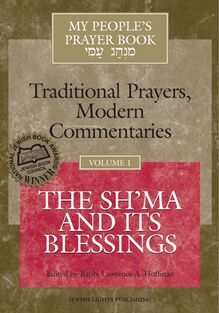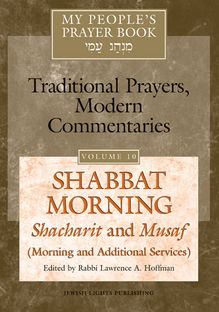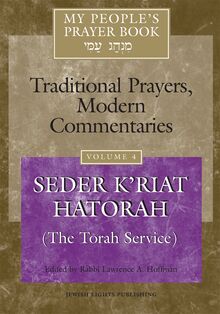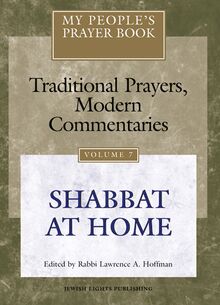-
 Univers
Univers
-
 Ebooks
Ebooks
-
 Livres audio
Livres audio
-
 Presse
Presse
-
 Podcasts
Podcasts
-
 BD
BD
-
 Documents
Documents
-
- Cours
- Révisions
- Ressources pédagogiques
- Sciences de l’éducation
- Manuels scolaires
- Langues
- Travaux de classe
- Annales de BEP
- Etudes supérieures
- Maternelle et primaire
- Fiches de lecture
- Orientation scolaire
- Méthodologie
- Corrigés de devoir
- Annales d’examens et concours
- Annales du bac
- Annales du brevet
- Rapports de stage
La lecture à portée de main
Vous pourrez modifier la taille du texte de cet ouvrage
Découvre YouScribe en t'inscrivant gratuitement
Je m'inscrisDécouvre YouScribe en t'inscrivant gratuitement
Je m'inscrisEn savoir plus
Vous pourrez modifier la taille du texte de cet ouvrage
En savoir plus

Description
Opens up the traditional Jewish prayer book as a spiritual resource....This groundbreaking new series involves us in a personal dialogue with God, history and tradition, through the heritage of prayer. "The prayer book is our Jewish diary of the centuries, a collection of prayers composed by generations of those who came before us, as they endeavored to express the meaning of their lives and their relationship to God. The prayer book is the essence of the Jewish soul." Framed with beautifully designed Talmud-style pages, commentaries from many of today's most respected Jewish scholars from all movements of Judaism examine Shabbat at home from the perspectives of ancient Rabbis and modern theologians, as well as feminist, halakhic, Talmudic, linguistic, biblical, Chasidic, mystical, and historical perspectives. My People's Prayer Book is a momentous multi-volume series that opens up the traditional Jewish prayer book (the Siddur) as a spiritual resource. Commentaries by respected teachers from all perspectives of the Jewish world provide the spiritual messages that make up the Siddur. Sometimes awe-striking, sometimes surprising, but always deeply spiritual, My People’s Prayer Book is a gateway to the riches that the heritage of prayer offers us in our worship, and in our lives. The seventh volume celebrates Shabbat as a central family ritual, tracing the development of this loosely structured liturgy from early prayer books that draw on the classical rabbinic era, through medieval Jewish practice and the influence of Lurianic mysticism. Pausing to explore the key moments that mark this sacred time —Erev Shabbat with Kiddush, Kiddusha Rabbah, and Motsa’ei Shabbat with Havdalah—Shabbat at Home captures the joy of this holy day’s prayers, blessings, and z’mirot (table songs), emphasizing the renewal of home liturgy in Jewish life and reinforcing the importance of Shabbat in the Jewish conception of time. Vol. 7—Shabbat at Home features the traditional Hebrew text with a new translation that lets people know exactly what the prayers say. Introductions explain what to look for in the prayers, and how to truly use the commentaries to find meaning in the prayer book. Commentaries from eminent scholars and teachers from all movements of Judaism examine Shabbat at Home from the viewpoints of ancient Rabbis and modern theologians, as well as a myriad of other perspectives. Even those not yet familiar with the prayer book can appreciate the spiritual richness of Shabbat at Home. My People’s Prayer Book enables all worshipers, of any denomination, to create their own connection to 3,000 years of Jewish experience with the world and with God. Each volume of My People’s Prayer Book provides a new translation of the authentic Hebrew text, with diverse and exciting commentaries to the traditional liturgy, written by many of today’s most respected scholars and teachers from all perspectives of the Jewish world. This stunning work, an empowering entryway to the spiritual revival of our times, enables all of us to claim our connection to the heritage of the traditional Jewish prayer book. It helps rejuvenate Jewish worship in today’s world, and makes its power accessible to all.
ABOUT MY PEOPLE'S PRAYER BOOK INTRODUCTION TO THE LITURGY OF SHABBAT AT HOME: WHY THE HOME? Lawrence A. Hoffman INTRODUCTION TO THE LITURGY OF SHABBAT AT HOME: WHY SHABBAT? Lawrence A. Hoffman SHABBAT Z’MIROT: AN EXPANDING FRONTIER OF THE JEWISH SPIRIT Lawrence A. Hoffman S’UDAH SH’LISHIT: A RITE OF MODEST MAJESTY Michael Chernick INTRODUCTION TO THE COMMENTARIES: HOW TO LOOK FOR MEANING IN THE PRAYERS Lawrence A. Hoffman THE LITURGY 1. WELCOMING SHABBAT A. HADLAKAT NEROT ("CANDLE LIGHTING") B. BIRKAT BANIM (“BLESSING OF CHILDREN”) C. SHALOM ALEIKHEM (“PEACE TO YOU”) D. ESHET CHAYIL (“A WORTHY WOMAN”). E. KIDDUSH (“SANCTIFICATION”) F. Z’MIROT (“TABLE SONGS”). . MY PEOPLE’S PRAYER BOOK vi I. YOM ZEH L’YISRA’EL (“THIS IS ISRAEL’S DAY”) II. D’ROR YIKRA (“LET HIM PROCLAIM FREEDOM”) III. Y’DID NEFESH (“SOUL’S COMPANION”). IV. SHABBAT HAMALKAH (“THE SHABBAT QUEEN”) 2. KIDDUSHA RABBAH (“THE GREAT KIDDUSH”) 3. BIDDING SHABBAT FAREWELL. A. HAVDALAH (“SEPARATION”) B. SHAVU’A TOV (“A GOOD WEEK”) C. ELIYAHU HANAVI (“ELIJAH THE PROPHET”) About the Contributors List of Abbreviations Glossary
Sujets
Informations
| Publié par | Turner Publishing Company |
| Date de parution | 18 juillet 2013 |
| Nombre de lectures | 0 |
| EAN13 | 9781580237727 |
| Langue | English |
Informations légales : prix de location à la page 0,0700€. Cette information est donnée uniquement à titre indicatif conformément à la législation en vigueur.
Extrait
R ead may be the wrong word. Engage would be better, because this is not so much a book as it is a classic text, and Jewish classics are not read so much as they are engaged. Included here is a classic text of Jewish prayer, spanning 2,000 years of Jewish experience with the world and with God; and nine thoughtful commentaries on that text, each one reaching back in a different way, again through 2,000 years of time. The question ought to be, Who should engage this book in personal dialogue?
If you like to pray, or find prayer services baffling: Whether you are Orthodox, Conservative, Reconstructionist, or Reform, you will find that My People s Prayer Book tells you what you need to know to pray. The Hebrew text here is the most authentic one we have, and the variations among the Jewish movements are described and explained. They are all treated as equally authentic. The translation is honest, altogether unique, and outfitted with notes comparing it to others translations. Of special interest is a full description of the Halakhah (the how to ) of prayer and the philosophy behind it.
If you are a spiritual seeker or Jewishly curious: If you have wondered what Judaism is all about, the prayer book is the place to begin. It is the one and only book that Jews read each and every day. The commentaries explain how the prayers were born, and synopsize insights of founding Rabbis, medieval authorities, Chasidic masters, and modern theologians. The layout replicates the look of Jewish classics: a text surrounded by many marginal commentaries allowing you to skip back and forth across centuries of insight.
If you are a teacher or a student: This is a perfect book for adult studies, or for youth groups, teenagers, and camps. Any single page provides comparative insight from the length and breadth of Jewish tradition, about the texts that have mattered most in the daily life of the Jewish people.
If you are a scholar: Though written in friendly prose, this book is composed by scholars: professors of Bible, Rabbinics, Medieval Studies, Liturgy, Theology, Linguistics, Jewish Law, Mysticism, and Modern Jewish Thought. No other work summarizes current wisdom on Jewish prayer, drawn from so many disciplines.
If you are not Jewish: You need not be Jewish to understand this book. It provides access for everyone to the Jewish wisdom tradition. It chronicles the ongoing Jewish-Christian dialogue, and the roots of Christian prayer in Christianity s Jewish origins.
The My People s Prayer Book: Traditional Prayers, Modern Commentaries series Volume 1- The Sh ma and Its Blessings 168 pp, 978-1-879045-79-8 Volume 2- The Amidah 240 pp, 978-1-879045-80-4 Volume 3- P sukei D zimrah (Morning Psalms) 240 pp, 978-1-879045-81-1 Volume 4- Seder K riat Hatorah (The Torah Service) 264 pp, 978-1-879045-82-8 Volume 5- Birkhot Hashachar (Morning Blessings) 240 pp, 978-1-879045-83-5 Volume 6- Tachanun and Concluding Prayers 240 pp, 978-1-879045-84-2 Volume 7- Shabbat at Home 240 pp, 978-1-879045-85-9 Volume 8- Kabbalat Shabbat (Welcoming Shabbat in the Synagogue) 240 pp, 978-1-58023-121-3 Volume 9- Welcoming the Night: Minchah and Ma ariv (Afternoon and Evening Prayer) 272 pp, 978-1-58023-262-3 Volume 10- Shabbat Morning: Shacharit and Musaf (Morning and Additional Services) 240 pp, 978-1-58023-240-1
Prayers of Awe Volume 1- Who by Fire, Who by Water- Un taneh Tokef 272 pp, 978-1-58023-424-5 Volume 2- All These Vows- Kol Nidre 288 pp, 978-1-58023-430-6 Volume 3- We Have Sinned:Sin and Confession in Judaism- Ashamnu and Al Chet 288 pp, 978-1-58023-612-6 Volume 4- May God Remember: Memory and Memorializing in Judaism- Yizkor 304 pp, 978-1-58023-689-8
My People s Passover Haggadah: Traditional Texts, Modern Commentaries Volume 1- 304 pp, 978-1-58023-354-5 Volume 2- 320 pp, 978-1-58023-346-0
Thank you for purchasing this Jewish Lights e-book!
Sign up for our e-newsletter to receive special offers and information on the latest new books and other great e-books from Jewish Lights.
Sign Up Here
or visit us online to sign up at www.jewishlights.com .
Looking for an inspirational speaker for an upcoming event, Shabbaton or retreat?
Jewish Lights authors are available to speak and teach on a variety of topics that educate and inspire. For more information about our authors who are available to speak to your group, visit www.jewishlights.com/page/category/JLSB . To book an event, contact the Jewish Lights Speakers Bureau at publicity@jewishlights.com or call us at (802) 457-4000.
INTRODUCTION TO THE LITURGY OF SHABBAT AT HOME: WHY THE HOME?
Lawrence A. Hoffman
INTRODUCTION TO THE LITURGY OF SHABBAT AT HOME: WHY SHABBAT?
Lawrence A. Hoffman
SHABBAT Z MIROT : AN EXPANDING FRONTIER OF THE JEWISH SPIRIT
Lawrence A. Hoffman
S UDAH SH LISHIT : A RITE OF MODEST MAJESTY
Michael Chernick
INTRODUCTION TO THE COMMENTARIES: HOW TO LOOK FOR MEANING IN THE PRAYERS
Lawrence A. Hoffman
THE LITURGY
1.WELCOMING SHABBAT
A. HADLAKAT NEROT ( CANDLE LIGHTING )
B. BIRKAT BANIM ( BLESSING OF CHILDREN )
C. SHALOM ALEIKHEM ( PEACE TO YOU )
D. ESHET CHAYIL ( A WORTHY WOMAN )
E. KIDDUSH ( SANCTIFICATION )
F. Z MIROT ( TABLE SONGS )
I. YOM ZEH L YISRA EL ( THIS IS ISRAEL S DAY )
II. D ROR YIKRA ( LET HIM PROCLAIM FREEDOM )
III. Y DID NEFESH ( SOUL S COMPANION )
IV. SHABBAT HAMALKAH ( THE SHABBAT QUEEN )
2. KIDDUSHA RABBAH ( THE GREAT KIDDUSH )
3.BIDDING SHABBAT FAREWELL
A. HAVDALAH ( SEPARATION )
B. SHAVU A TOV ( A GOOD WEEK )
C. ELIYAHU HANAVI ( ELIJAH THE PROPHET )
About the Contributors
List of Abbreviations
Glossary
CONTRIBUTORS
MARC BRETTLER: Our Biblical Heritage
MICHAEL CHERNICK S udah Sh lishit: The Third Shabbat Meal
ELLIOT N. DORFF: Theological Reflections
DAVID ELLENSON: How the Modern Prayer Book Evolved
ELLEN FRANKEL: A Woman s Voice
ALYSSA GRAY: Our Talmudic Heritage
JOEL M. HOFFMAN: What the Prayers Really Say
LAWRENCE A. HOFFMAN: History of the Liturgy
LAWRENCE KUSHNER AND NEHEMIA POLEN: Chasidic and Mystical Perspectives
DANIEL LANDES: The Halakhah of Prayer
Why the Home?
Lawrence A. Hoffman
PRAYER BOOKS, SYNAGOGUE, AND HOME
Normally, we think of the prayer book (or Siddur [pronounced see-DOOR or, commonly, SIH-d r] as it is called) as containing the liturgy for the synagogue, and indeed, that is correct. But the original prayer books from the period called the geonic era (c. 750-1034), and their medieval successors, too, contained much more than that. They were compendia of prayer in general and included not only synagogue prayers for the entire year, but also prayers said privately (such as the bedtime Sh ma ) or at home with the family (the entire Passover Haggadah, for instance, or the home liturgy for Shabbat, the topic of this volume). Instructions were liberally interspersed alongside the prayers, providing the information people needed for their life of prayer, whether communal or private.
The important point is that the printing press had yet to be invented, so these early prayer books were hard-to-get handwritten documents copied painstakingly by scribes, and not for private use but for the community. Prayer leaders might read from the book as they recited the liturgy aloud at services; individuals who, normally, didn t have their own copies would request instructions on how to pray at home and receive answers based on what the leaders read in the town s official copy. The Siddur became not just a book of prayer, but also a standard reference guide to be consulted for everything from how to say the morning Sh ma to the requisite customs for a funeral. All of that would change with the invention of printing.
Europeans were not the first to develop the modern technology of printing. Koreans were using it as early as 1403. But it was being studied independently by Europeans-including at least one Jew, Davin de Caderousse of Provence-by the 1440s, when Johannes Gutenberg (1400-1468) set up his epochal printing press. Its breakthrough was its use of a technology that made it possible to print from individual letters cast in moveable metallic type, rather than inking a wood or metal block that could print only an entire page (or part, thereof), but could not be disassembled and put back together again, letter by letter, in other combinations. Scribal replication of manuscripts would soon become obsolete, a consequence not lost on scribes who frequently opposed the new technology on theological grounds. But the revolution was not immediate. Printed books were still costly and rare. William Caxton, for instance, the first British printer, set up a press in Westminster in 1476 but managed to produce only about a hundred items in almost twenty years.
About the same time (1475), the first dated Hebrew books were being printed (some, without dates, may have come somewhat earlier); and by the sixteenth century, printing was becoming feasible on a wide-scale basis. Up until then, reading had been a public, not a private, matter-Benedictine monks, for example, spent four hours a day being read to. But by 1597, books were becoming sufficiently standard, at least among the élite, that it was felt necessary to impose imperial censorship over the Frankfurt book fair. Also in the sixteenth century, the great publishing houses for Jewish books made their appearance.
Still, with output necessarily limited, printers had to choose their Jewish titles carefully and design them to the taste of what was still a very tiny moneyed clientele. Liturgical works were obvious candidates for inclusion. A prayer book was the first publication of a Hebrew printing press established in Prague in 1512, and beautifully designed versions of Italian prayer books printed on p
-
 Univers
Univers
-
 Ebooks
Ebooks
-
 Livres audio
Livres audio
-
 Presse
Presse
-
 Podcasts
Podcasts
-
 BD
BD
-
 Documents
Documents
-
Jeunesse
-
Littérature
-
Ressources professionnelles
-
Santé et bien-être
-
Savoirs
-
Education
-
Loisirs et hobbies
-
Art, musique et cinéma
-
Actualité et débat de société
-
Jeunesse
-
Littérature
-
Ressources professionnelles
-
Santé et bien-être
-
Savoirs
-
Education
-
Loisirs et hobbies
-
Art, musique et cinéma
-
Actualité et débat de société
-
Actualités
-
Lifestyle
-
Presse jeunesse
-
Presse professionnelle
-
Pratique
-
Presse sportive
-
Presse internationale
-
Culture & Médias
-
Action et Aventures
-
Science-fiction et Fantasy
-
Société
-
Jeunesse
-
Littérature
-
Ressources professionnelles
-
Santé et bien-être
-
Savoirs
-
Education
-
Loisirs et hobbies
-
Art, musique et cinéma
-
Actualité et débat de société
- Cours
- Révisions
- Ressources pédagogiques
- Sciences de l’éducation
- Manuels scolaires
- Langues
- Travaux de classe
- Annales de BEP
- Etudes supérieures
- Maternelle et primaire
- Fiches de lecture
- Orientation scolaire
- Méthodologie
- Corrigés de devoir
- Annales d’examens et concours
- Annales du bac
- Annales du brevet
- Rapports de stage













